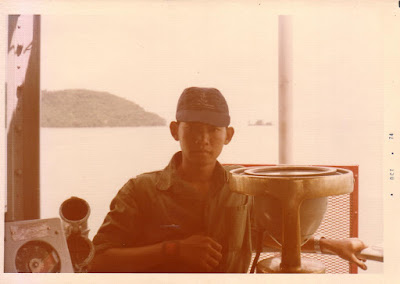My first posting was to RSS Freedom. The captain has the reputation of being the ‘most on’ in the navy. The XO was highly intelligent. Apparently he scored straight ‘A’s at “O” Level but didn’t want any further study. From the time I stepped on board, I was asked questions after questions. Of course I couldn’t answer most and was humiliated to the dogs. It was ragging of sort or could have been the navy way of ‘initiation’ to be an officer. I felt terrible but deep in my heart I had made up my mind to persevere, especially after going through the storm over the Bay of Bengal. I learnt the hard ways but didn’t mind all the hurts; I was focus to be commission as officer.

Most of the training was keeping watch on the bridge, when the ship conducted patrol on the busy lanes in the Straits of Singapore between Horsburgh Lighthouse, St. John Islands and to the west, Raffles Lighthouse. Here we applied Rules of the Seas, either by taking avoiding actions or stay the course. It was more complex at night when you only see the lights of the ships. I also familiarised myself with the sea boundaries between the littoral states of Indonesia and Malaysia and learned to recognise the types of ships. Here I learnt that Indo custom boats we call ‘BT’ often went after our fishing boats for money.
RSS Dauntless
My second posting was to a ‘B’ class patrol craft. I couldn’t remember much what happen during those 2 months. I can only deduce that it was uneventful. Perhaps the captain must be rather ‘switch off’.
 RSS Dragon
RSS DragonThis was a Missile Gun Boat or MGB, the most important and v

aluable asset in the navy. It was commanded by a senior officer. The ship can speed up the 45 knots. When she did that, she was like skiing on the s
ea, leaving behind the ship an awful wake from the 4 powerful engines.
The captain left us to the ship’s XO to train us. I was treated with more respect and given duties on the bridge under the supervision of the other officers.
Rammed a Fishing Boat.
One night, a suspicious boat was detected on the radar. I said suspicious because, her lights were all switched off which should not be the case. The captain was awakened and decided to investigate. That night my assigned duty was to manage the throttle control (like accelerator on a car). The captain manoeuvred the ship by giving commands to advance or reverse the engines through 4 throttle levers. As the spotlight shone on the boat, I noticed it to be an Indonesian wooden fishing boat as the crew spoke Malay. The captain wanted to get nearer the boat and gave a series of command on the throttle. Instead of pushing the lever backward, I inadvertently advance it, causing the ship to surge forward and rammed the fishing boat in the right bow (front). I remembered dreadfully a few pieces of planks broke. The damage was not very serious. I was relieved of my duties immediately. The captain spoke to the fisherman but I was too dumbfounded to follow the conversation.
Taking responsibility
The fishermen were warned to stay off Singapore water and left without further incident. I was reprimanded for my mistake and was very remorseful but I felt he was far too lenient to me. For the next few hours, I was totally dazed, sad and worried as the reality sank in. What happen if that boat was badly damaged? What if he reports me to my superiors? Will my officer training be terminated and my aspiration destroyed? I saw him next day but I dare not raise any questions. Weeks passed and nothing happened and I was relieved.
I appreciated that as a captain, he has taken the responsibility for someone else mistake. He was forgiving and wasn’t hard on me. It is lesson of humility for me. Be firm, kind and understanding to your men under your charge and you will earn eternal respect from them.
Steep Learning Curve
The last 5 months of on-the -job training has exposed me to actual duties I was expected to confront in the future. I had observed the styles and mannerism of many officers and it’s for me to emulate the good and avoid the bad. It was really a steep learning curve. I was 19 and soon I had to handle men double my age. Some men literally “eaten more salt” than me. I still need to improve and develop my interpersonal skill. Indeed, learning will never end. That is a fact of life.
Soon I will receive my commission and this chapter of my life will closed and new chapter will begins
--------------------






















